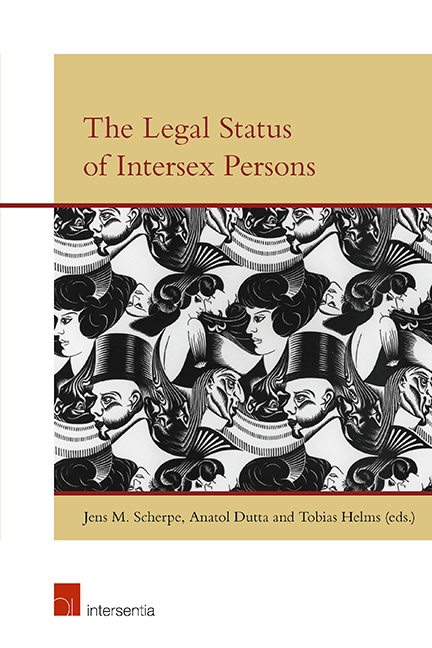Book contents
- Frontmatter
- Preface
- Contents
- List of Contributors
- The Legal Status of Intersex Persons: An Introduction
- Malta Declaration
- Darlington Statement
- Vienna Statement
- PART I MEDICINE AND PSYCHOLOGY
- PART II THEOLOGY AND LEGAL HISTORY
- PART III TRANSGENDER, TRANSSEXUALITY AND INTERSEX
- PART IV NATIONAL LEGAL DEVELOPMENTS
- Australia
- Sweden
- India
- The Netherlands
- France
- Colombia (The Colombian Constitutional Court)
- United States
- Malta
- Germany (The 2013 German Law)
- Germany (German Inter-Ministerial Working Group)
- Germany (Gender Diversity in Law)
- PART V PRIVATE INTERNATIONAL LAW ASPECTS OF INTERSEX
- PART VI INTERSEX AND HUMAN RIGHTS
Australia
from PART IV - NATIONAL LEGAL DEVELOPMENTS
Published online by Cambridge University Press: 31 January 2019
- Frontmatter
- Preface
- Contents
- List of Contributors
- The Legal Status of Intersex Persons: An Introduction
- Malta Declaration
- Darlington Statement
- Vienna Statement
- PART I MEDICINE AND PSYCHOLOGY
- PART II THEOLOGY AND LEGAL HISTORY
- PART III TRANSGENDER, TRANSSEXUALITY AND INTERSEX
- PART IV NATIONAL LEGAL DEVELOPMENTS
- Australia
- Sweden
- India
- The Netherlands
- France
- Colombia (The Colombian Constitutional Court)
- United States
- Malta
- Germany (The 2013 German Law)
- Germany (German Inter-Ministerial Working Group)
- Germany (Gender Diversity in Law)
- PART V PRIVATE INTERNATIONAL LAW ASPECTS OF INTERSEX
- PART VI INTERSEX AND HUMAN RIGHTS
Summary
INTRODUCTION
The legal status of intersex persons of Australia is complicated by the very structure of the Australian legal system. Australia is a federal system, with competence for areas of law divided according to the Constitution. However, the regulation of sex and gender identity falls across several different areas of competence, leaving a patchwork of inconsistent, and at times contradictory, laws.
While states and territories have competence in the area of registration of births – and thus the registration of sex on the birth certificate – the commonwealth holds competency in relation to marriage (and its definition), and the issuance of passports. As such, it is possible for individuals to have two documents used to establish legal identity – the passport and the birth certificate – declaring a different gender. This situation is complicated even further by the fact that different states and territories have established different rules concerning the registration of sex on the birth certifcate, as well as how an individual can register a change of gender.
This chapter will attempt to summarise the key features of these various laws, starting with the registration of an intersex child on a birth certificate in different states and territories, then go on to discuss how the birth certificate can be changed at a later date. It will then move to recognition of intersex as a status on a federal level, and the consequences of conflicts between these differing regimes.
It must be recognised that most of the laws in this regard are drafted with transgender individuals in mind, rather than being intended to address the specific context of intersex individuals. Although this is starting to change, with the Australian Capital Territory (ACT) and South Australia leading the way, many states still do not have any legal recognition or protection of intersex individuals. In the absence of more specific and appropriate laws in this regard, the more general transgender mechanisms will be examined to consider whatever imperfect protection can be provided to intersex individuals.
- Type
- Chapter
- Information
- The Legal Status of Intersex Persons , pp. 243 - 254Publisher: IntersentiaPrint publication year: 2018
- 1
- Cited by



